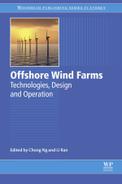Wind turbine gearbox design with drivetrain dynamic analysis
Abstract
This chapter focuses on the fundamentals of designing a gearbox for a wind turbine and analysis of the associated drivetrain dynamics. First of all, some aspects of early stage design considerations and typical gear layout arrangements (ie, parallel shaft and planetary systems) are discussed. The preliminary design considerations lead to major decisions, such as on the configuration of the gearbox (modular or integral), number of stages, type of layout (parallel or planetary), etc. Following the discussion on early stage design considerations more detailed design principles at the development and production stages are presented. Some of the recommendations following ISO/IEC 61400-4 are also highlighted. Aspects on gear manufacture and inspection are also briefly discussed. Finally, analysis of drivetrain dynamics, variable loading on gearbox and fatigue design of gear teeth are presented. A simple two-mass model of the drivetrain shaft has been presented in the context of dynamic analysis and the importance of electromechanical coupling has been highlighted, including the generator dynamics.
Keywords
Concept design; Drivetrain dynamics; Electromechanical coupling; Fatigue design; Inspection and maintenance; Load spectrum; Parallel gear shaft; Planetary gear; Speed-up ratio; Variable loading7.1. Introduction

7.2. WTGS gearbox design – concept stage
7.2.1. Basic operation of the WTGS gearbox
![]() [7.1]
[7.1]
![]() [7.2]
[7.2]
![]() [7.3]
[7.3]
![]() [7.4]
[7.4]
![]() [7.5]
[7.5]
![]() [7.6]
[7.6]
![]() [7.7]
[7.7]
7.2.2. Early stage design considerations
7.2.3. Concept variants for WTGS gearbox
![]() [7.8]
[7.8]
![]() [7.9]
[7.9]
![]() [7.10]
[7.10]
![]() [7.11]
[7.11]
7.3. WTGS gearbox design – development stage

7.3.1. Gear design
Table 7.1
Applicable gear standards for gear component design
| Failure mode | Relevant details (as cited in ISO/IEC 61400-4) |
| Gear pitting | ISO 6336 series Minimum safety factor, SH = 1.25 |
| Bending | ISO 6336 series Minimum safety factor, SF = 1.56 Life factors, ZNT and YNT, determined using 0.85 × 1010 cycles |
| Scuffing | ISO/TR 13989-1 DIN 3990-4 ANSI/AGMA 925-A02 + ISO/TR 13989-2 |
| Micropitting | ISO/TR15144-1 |
| Static strength | ISO 6336 series Evaluated at extreme torque using static life factors YNT and ZNT Minimum safety factor for root bending, SF > 1.4 Minimum safety factor for surface durability, SH > 1.0 |
| Subsurface-initiated fatigue | DNV classification note 41.2 (subclause 2.13) |
7.4. WTGS gearbox design – production stage
7.4.1. Gear manufacture and inspection
7.5. Drivetrain dynamic analysis
7.5.1. Variable loading
7.5.2. Drivetrain dynamics
7.5.3. Two-mass drivetrain shaft model

![]() [7.12]
[7.12]
![]() [7.13]
[7.13]
![]() [7.14]
[7.14]
![]() [7.15]
[7.15]
![]() [7.16]
[7.16]
7.5.4. Coupled electromechanical interaction

 [7.17]
[7.17]
7.5.5. Effect of variable loading on fatigue design of gear teeth
 [7.18]
[7.18]
![]() [7.19]
[7.19]
 [7.20]
[7.20]








